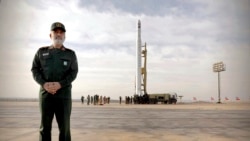IRGC Commander Hossein Salami says the launch of Iran's first military satellite on Wednesday April 22 marks the "beginning of the formation of a world power."
In a handwritten message displayed on the IRGC's Tasnim news agency, Salami said: "Now we look at the earth from the Sky."
Addressing IRGC personnel, Salami wrote: "My brothers! The road has been opened. Do not stop. March on!"
Later on Wednesday, Tasnim quoted him as saying that the successful launch of the Noor [light] satellite has "boosted Iran's defensive power and facilitated the country's supremacy." He further called the development a "leap," adding that the message of the achievement was that sanctions did not stop Iran.
While it was Iran's telecommunications minister Mohammad Javad Azari Jahromi who announced the failures in Iran's space program, the claim of victory came from the commander-in-chief of the revolutionary guards.
The IRGC says the satellite has been placed in an orbit 425 kilometres above the earth. However, no independent international source has confirmed the "successful launch" as the guards like to call it.
This was Iran's fifth attempt to launch a satellite into orbit. The four previous attempts had failed. One of the worst of these failures took place in August 2019 when according to Iranian officials the rocket that was going to carry a satellite into the space exploded on the launch pad.
Iran's space program is criticized by Western powers as a disguise for its missile program. The United States has also assessed Iran's space program as part of its missile program. U.S. Secretary of State Mike Pompeo in early February accused Iran of honing its ballistic missile skills through a satellite launch and vowed to exert more pressure.
"The United States will continue to build support around the world to confront the Iranian regime's reckless ballistic missile activity, and we will continue to impose enormous pressure on the regime to change its behavior," Pompeo said in a statement following Iran's latest failure to launch a satellite into orbit.
Responding to the United States and France's criticism of Iran's adventurism in space, Abbas Mousavi, the Spokesperson for Iran's Foreign Ministry characterized the two countries statements as "interventionist," and said "launching satellites and developing science and technology were Iran's natural rights."
In another development earlier, the United States had accused Iran of flouting a United Nations Security Council resolution by launching its most advanced satellite-carrying rocket to date. U.S. State Department spokeswoman Heather Nauert said in July 2019 the "provocative act" also violates the "spirit" of Tehran's 2015 nuclear agreement with world powers. "We consider that to be continued ballistic-missile development," Nauert said.
Meanwhile, according to Jahromi, in February, the rocket's insufficient speed was the reason for the failure of the previous launch.
This time, the IRGC called the launch "a great achievement and a new development for the Islamic Republic's space program."
A diagram published by the IRGC's Tasnim news agency summed up the evolution of Iran's missile industry and the journey from Safir-1 satellite carrier in 2008 to the 2019 Ghaem model .
The report said that the satellite was launched from Shahroud region near Iran's central desert and published pictures of the area but did not say when the pictures were taken.
The report added that the Noor satellite can perform visual monitoring using visual and thermal technology, facilitate secure communication between command centers and ground and airborne units. However, it cannot be used for navigation and geolocation purposes as this needs more than a few satellites.
Tasnim predicted that the launch of the military satellite can boost the speed of progress for Iran's space program and can meet Iranian forces' operational needs in sensitive defense and security areas.






